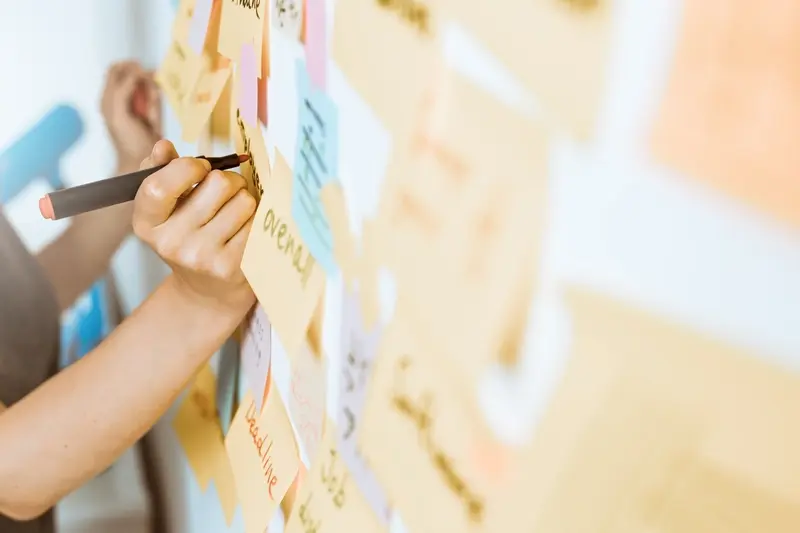What Features Should I Include In My First App Version?
Nearly 80% of mobile apps fail within their first year—and the biggest culprit isn't poor marketing or bad design, it's feature bloat. Developers cram their first version with every brilliant idea they've ever had, turning what could be a sleek, focused app into a confusing mess that nobody wants to use. I see this mistake repeatedly when new clients approach us with their "revolutionary" app concepts that somehow need to do everything except make your morning coffee.
The truth is, your first app version should be lean, focused, and built around solving one specific problem really well. This approach—building a minimum viable product or MVP—isn't about cutting corners or being lazy. It's about being smart with your resources and actually giving your app a fighting chance in the market.
The best first versions of apps feel almost embarrassingly simple when you look back at them, but they solved a real problem perfectly
Throughout this guide, we'll walk through the exact process for identifying which MVP features deserve a spot in your first release and which nice-to-have features should wait. You'll learn how to prioritise essential app features based on real user needs, avoid the common traps that sink most first-time app developers, and create a roadmap that sets you up for long-term success rather than short-term confusion.
Understanding Your App's Core Purpose
Before you even think about what buttons to include or how pretty your app should look, you need to answer one simple question: why does your app need to exist? I've seen countless app projects fail because founders skipped this step—they jumped straight into feature lists without understanding their app's reason for being.
Your app's core purpose isn't just what it does; it's the problem it solves for real people. Maybe you're helping busy parents order groceries faster, or you're making it easier for students to split restaurant bills. Whatever it is, you should be able to explain it in one clear sentence without using any technical jargon.
The Three Questions That Matter
When I work with new clients, I always ask them these three questions. They might seem obvious, but you'd be surprised how many people struggle to answer them clearly:
- What specific problem does your app solve?
- Who exactly has this problem?
- Why can't they solve it with existing apps or methods?
If you can't answer these questions confidently, your app will struggle to find its audience. People don't download apps because they're nice—they download them because they need something fixed in their life. Once you nail down your core purpose, every feature decision becomes much clearer.
Identifying Must-Have Features vs Nice-to-Have Features
Right, let's get straight to the point here—this is where most people mess up their MVP features. I see it all the time: someone comes to me with a brilliant app idea and then proceeds to list forty-seven different things they want it to do. My response? Take a deep breath and let's talk about what your app actually needs to survive in the wild.
The trick to building a successful minimum viable product app is being brutally honest about what your users absolutely cannot live without. Not what would be cool to have, not what your competitor has, but what solves the core problem you identified earlier. If someone downloads your app and can't complete the main task they came for, you've failed—simple as that.
The Reality Check Method
Here's what I do with clients: we write down every feature they want, then I ask them to imagine they only have enough budget for three features. Which three would they pick? It's painful but necessary. Those essential app features are your must-haves; everything else goes on the nice-to-have list for later versions.
Create two columns on a piece of paper: "App dies without this" and "Would be lovely to have". Be ruthless with your app feature prioritisation—your budget will thank you later.
Remember, you're not building the final version of your app right now. You're building something that proves your idea works and gets real users through the door.
User Research and Feature Validation
Here's something I learned the hard way after years of building apps—what you think users want and what they actually want are often two completely different things. I've watched brilliant developers spend months building features that nobody uses because they never bothered to ask real people what they needed.
User research doesn't have to be complicated or expensive. Start simple: talk to five people who represent your target audience. Show them your app idea and ask what problems they're trying to solve. Listen carefully to their words—not just what they say they want, but the actual problems they describe.
Quick Validation Methods
Once you've identified potential features, test them before you build. Create simple mockups or wireframes and show them to users. Ask them to walk through common tasks and watch where they get confused or frustrated.
- Paper sketches or digital wireframes work perfectly for early testing
- Ask users to talk through what they expect each button to do
- Watch for hesitation—it usually means something isn't clear
- Test with people who don't know your app idea inside out
Making Sense of Feedback
Not all feedback is equal. When someone says "I need this feature," dig deeper. What problem are they actually trying to solve? Sometimes the solution they suggest isn't the best way to fix their real problem. Focus on understanding the underlying needs rather than just collecting feature requests.
Technical Constraints and Development Reality
Let's talk about something most people don't want to hear—your dream feature list will get cut down. Hard. I've watched countless clients walk into meetings with spreadsheets full of amazing ideas, only to discover that building an MVP isn't about cramming everything in; it's about being ruthlessly practical.
Time and budget are your biggest enemies here. That fancy AI chatbot you want? It could eat up three months of development time and half your budget. The complex user authentication system with social logins? Another month gone. When you're working with limited resources, every feature decision becomes a trade-off between what's possible and what's smart for your minimum viable product app.
Platform Limitations Matter
Your chosen platform will dictate what's realistic too. iOS and Android handle things differently, and certain features might work beautifully on one but cause headaches on the other. Native features like camera integration or push notifications are straightforward, but custom animations or complex data processing can become development nightmares.
The best apps aren't the ones with the most features—they're the ones that do a few things exceptionally well within their technical means
Smart app feature prioritisation means accepting these constraints early. Focus your essential app features on what's technically achievable within your timeline and budget, not what sounds impressive in a pitch deck.
Feature Prioritisation Frameworks That Actually Work
Right, let's get practical. You've got a list of features as long as your arm and you need to decide what makes the cut for version one. I've seen too many app projects go sideways because teams couldn't make these tough decisions—or worse, they tried to build everything at once.
The MoSCoW method is my go-to framework for most projects. It's simple but effective: Must have, Should have, Could have, and Won't have (this time). The beauty is in that last category—Won't have forces you to park features rather than delete them completely. Your Must-haves become your MVP; everything else gets pushed to future releases.
The Value vs Effort Matrix
When MoSCoW isn't enough, I pull out the value versus effort matrix. Plot each feature on a grid: high value and low effort features are obvious wins, whilst high effort and low value features get binned immediately.
- Quick wins: High value, low effort
- Big bets: High value, high effort
- Fill-ins: Low value, low effort
- Time wasters: Low value, high effort
The Kano model adds another layer by categorising features as basic expectations, performance needs, or delighters. Basic expectations won't wow users but their absence will annoy them—think login functionality. Delighters are those unexpected touches that make users smile.
Common First Version Mistakes to Avoid
After working with hundreds of clients over the years, I've seen the same MVP features mistakes repeated time and time again. The most common one? Trying to build everything at once. People get excited about their app idea and want to include every feature they've ever dreamed of in version one—it's like trying to stuff a turkey with Christmas dinner, Boxing Day leftovers, and next week's meal prep all at the same time!
The Feature Creep Trap
Feature creep happens when you keep adding "just one more thing" to your minimum viable product app. What starts as a simple photo-sharing app suddenly needs filters, messaging, video calls, and a built-in photo editor. Before you know it, your three-month project becomes a year-long nightmare that costs three times more than planned.
Ignoring Your Users' Voice
Another massive mistake is building essential app features based on what you think users want rather than what they actually need. I've watched brilliant developers spend months perfecting features that users completely ignored once the app launched. Your app feature prioritisation should always start with real user feedback, not assumptions.
Test your core features with real users before adding anything fancy. A simple prototype shown to five people will teach you more than months of guessing.
The golden rule? Start small, launch fast, and learn quickly. Your first version should solve one problem really well, not ten problems poorly.
Planning Your Feature Roadmap Beyond Launch
Here's something most people don't think about when building their first app—what happens after launch? I've watched countless app owners scramble after their app goes live, wondering what features to add next. Don't be one of them.
Your roadmap should be flexible but planned. Start by categorising future features into three buckets: user-requested improvements, performance upgrades, and growth features. User feedback will guide the first category—listen to your actual users, not just what you think they want. Performance upgrades keep your app running smoothly as you gain more users. Growth features help you reach new audiences or increase engagement.
Building Your Feature Pipeline
I recommend planning features in three-month chunks. Any longer and you're guessing; any shorter and you're not thinking strategically. Track which features your users actually use—this data will surprise you.
- Review user analytics monthly to spot usage patterns
- Keep a backlog of feature requests from real users
- Plan technical debt fixes alongside new features
- Set aside budget for unexpected urgent fixes
When to Say No
The hardest part isn't deciding what to build—it's deciding what not to build. Every feature request feels important, but adding too much too fast will confuse your users and stretch your resources thin. Stay focused on your app's core purpose and let that guide your decisions.
Conclusion
Building your first app version is all about making smart choices—not perfect ones. I've watched countless founders tie themselves in knots trying to include every feature they can think of, and it never ends well. The apps that succeed are the ones that do a few things brilliantly rather than everything poorly.
Your MVP features should solve one clear problem for your users. That's it. Everything else can wait. User research will tell you what matters most, and the frameworks we've covered will help you prioritise ruthlessly. Don't worry about what your competitors are doing or what fancy features other apps have—focus on what your users actually need.
The beauty of mobile app development is that you can always add more features later. Your first version is just the beginning of the conversation with your users, not the end of it. Listen to their feedback, watch how they use your app, and build your roadmap based on real data rather than assumptions.
Keep it simple, launch sooner than you think you should, and remember that a minimum viable product app in the hands of users is worth ten perfect apps that never see the light of day. Your users will tell you what comes next—you just need to give them something to react to first.
Share this
Subscribe To Our Learning Centre
You May Also Like
These Related Guides

What Features Should I Include in My App MVP?

How Do I Prioritise My Mobile Apps Features?



